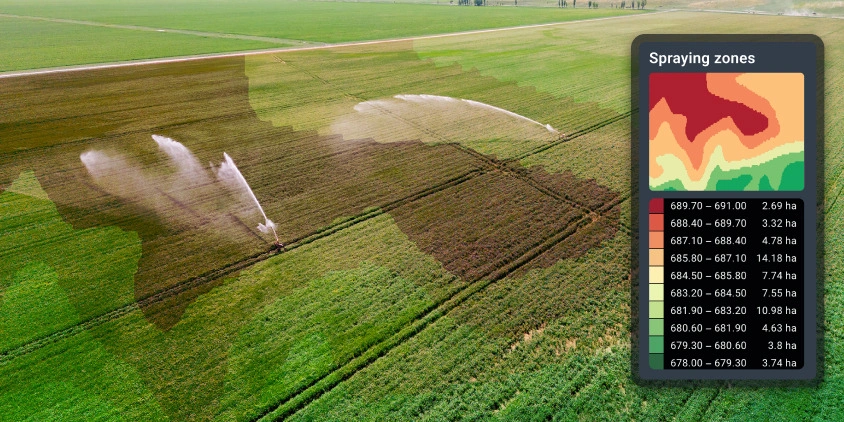
Variable Rate Irrigation Technology And Its Benefits
Water management in commercial farming is becoming more precise and data-driven. Variable rate irrigation (VRI) helps growers apply different amounts of water to different zones within their fields based on specific growing conditions and crop needs. When it comes to sites with highly varied soil and vegetation conditions, variable rate technology shines.
Irrigation sensors and precision agriculture software for variable rate irrigation now make it easier to analyze field data and swiftly adjust watering prescriptions. By reducing overwatering in some areas while properly irrigating others, VRI helps growers cut water waste, prevent nutrient leaching, and maintain consistent crop quality across fields.
What Is Variable Rate Irrigation And How Does It Work?
Variable rate irrigation is a novel agricultural technology that fine-tunes water application to match the specific needs of different areas within a field. It recognizes that uniform irrigation often fails to address the natural variations in soil composition, topography, and crop water requirements across a single field. Some farmers still use the tried-and-true method of simply not planting in areas that are usually either too wet or too dry. But this has all changed with variable rate irrigation, which allows for crop cultivation in previously unsuitable zones by adjusting the water level.
Variable rate irrigation systems typically incorporate several high-tech components to achieve precision in water management:
- GPS (Global Positioning System) for accurate sprinkler positioning;
- satellite and/or aircraft imagery and GIS (Geographic Information System) for mapping and data analysis;
- soil moisture sensors for real-time water content monitoring;
- weather stations for local and hyperlocal climate data integration;
- irrigation controllers that switch particular sprinklers or their groups on and off to adjust applications in real time.
By adopting VRI, industrial growers can expect increased water use efficiency, lower pumping energy costs, and higher crop yields due to optimized growing conditions. On top of that, the variable rate irrigation system can be integrated with fertigation technologies for precise nutrient applications, further increasing field productivity and resource efficiency.
Types Of Variable Rate Irrigation
Growers can choose between two main VRI approaches, each suited for specific field conditions and management goals:
- Sector or speed variable irrigation. It segments the field into pie-slice-shaped sections, adjusting water application rates through pivot speed and depth control. This variable rate technology is suitable for fields with consistent soil patterns along the length of the pivot. This technology is common in variable rate center pivot irrigation control systems .
- Variable zone irrigation. Instead of using large, uniform sectors, it divides fields into smaller, more dispersed management zones, allowing for more precise watering. It excels in challenging field conditions when integrated with micro-irrigation and variable rate drip irrigation systems.
Let’s look at how these capabilities of VRI systems translate into measurable benefits.
Benefits Of Variable Rate Irrigation For Agriculture
To water just about 25% of the world’s arable land, farmers use up around 70% of available freshwater each year . Variable rate irrigation offers a solution, reducing water consumption in agriculture and increasing crop output at the same time. VRI also supports sustainable development, aligning with several UN Sustainable Development Goals .
Water Conservation And More Resilience Against Drought
Variable rate watering can reduce moisture application to agricultural sites through:
- selective application: refrain from irrigating uncultivated and marginal lands;
- targeted distribution: cut back on irrigating lowlands, poorly drained areas, and soils that retain more water.
Thus, VRI systems can help crop producers minimize water waste and reduce the need for freshwater, which is particularly important in arid regions.
Higher Crop Yields
Irrigation with variable rate technology means delivering water to crops in need in the amount they need. By adjusting watering based on soil moisture, crop type and growth stage, farmers can reduce water stress and optimize plant growth. Variable rate application minimizes over- and underwatering, resulting in better crop quality and higher quantity.
Reduced Production Costs
Precision variable rate irrigation can slash production costs for commercial growers in several major areas:
- Pumping. Less water used means less water pumped and lower energy costs for operating pumps (the most significant in areas with deep water tables).
- Weed management. Not providing moisture and nutrients to non-cropped areas naturally suppresses weeds. This lowers the need for labor-intensive control measures and pricey herbicides.
- Fertilizing. Lessening the amount of water that runs off the field helps keep nutrients in. Another way to cut down on liquid fertilizers and their associated expenses is to apply variable rate fertilizer through fertigation systems.
These and other benefits of variable rate irrigation technology may interest many farmers. However, whether they can acquire those benefits depends heavily on the data and analytical tools they use to determine VRI management zones and each zone’s moisture requirements at different times.
How To Get The Most Of VRI With EOSDA Crop Monitoring
EOSDA Crop Monitoring uses satellite imagery for agricultural mapping to support variable rate irrigation decisions. The platform shows both constant field features like slopes and ravines and ever-changing crop conditions. This information, which helps growers see where moisture is needed, translates into more effective irrigation planning.
Our precision farming platform allows agriculture consultants, crop producers, farmers and other agricultural players to create variable rate irrigation maps using two types of satellite imagery:
- historical imagery helps account for past season patterns (e.g., yields) and relatively constant field characteristics (e.g., elevations), as well as their alterations to inform long-term VRI planning;
- current imagery shows recent crop conditions to guide immediate adjustments in variable rate irrigation.
The following steps will walk you through using our satellite crop monitoring tools for the best results of your variable rate irrigation.
Choose The Most Relevant Layers For Your Field
EOSDA Crop Monitoring offers different map layers for smart VRI planning. Let’s examine some of the most widely used options:
- The elevation layer shows you where your field has lowlands, plains, and highlands. This matters because water flows differently on uneven ground. With this information, you can plan variable applications and avoid dry spots in high areas and soggy patches in low areas.
- The NDMI layer visualizes current moisture levels in your crops. It shows which parts of your site are wet and which are dry right now. This enables you to irrigate only where necessary at particular variable rates.
- The NDVI layer shows variations in crop health and vigor across the field. Healthier, more vigorous areas with higher NDVI values may require less moisture, while stressed areas with lower values may need more moisture. By combining elevation and NDVI layers, you can make VRI scripts work even better.
Using these layers for VRI, you’ll consume less water overall and keep your crop moisture needs satisfied — not too dry, not too wet.
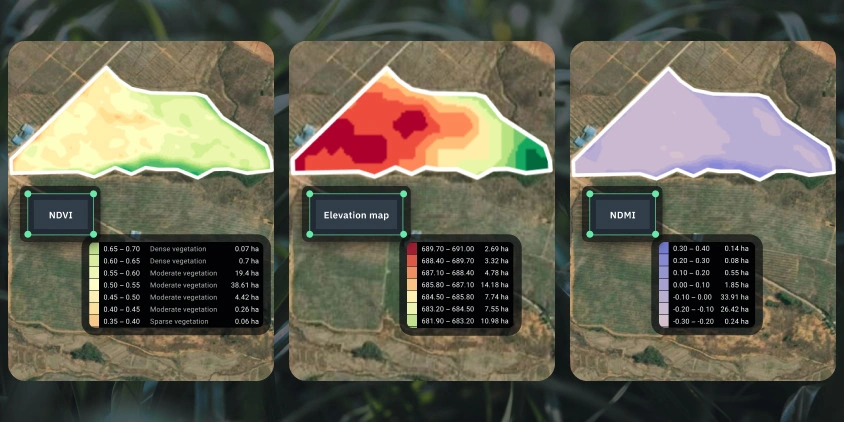
Generate The VRI Map
The Map Builder tool in EOSDA Crop Monitoring allows you to create variable rate irrigation scripts with the layers that you find the most applicable to your fields. To divide the field into VRI management zones, follow these few steps:
- First, select an existing field from your account or draw a new one. Since the platform’s coverage area exceeds 95% of the planet’s surface, you can analyze fields basically anywhere in the world.
- Once you’ve chosen your field, navigate to the VRA maps section and open the Map builder tool.
- To create a new VRI map, you’ll need to specify a few key parameters: the number of zones you need; the level of detail, with five different options available to suit your needs; the data layers you want to use, which can be a single layer or a combination. Some of the most popular layers for variable rate irrigation mapping include NDVI, elevations, the combination of NDVI and elevations, NDMI, and MSAVI.
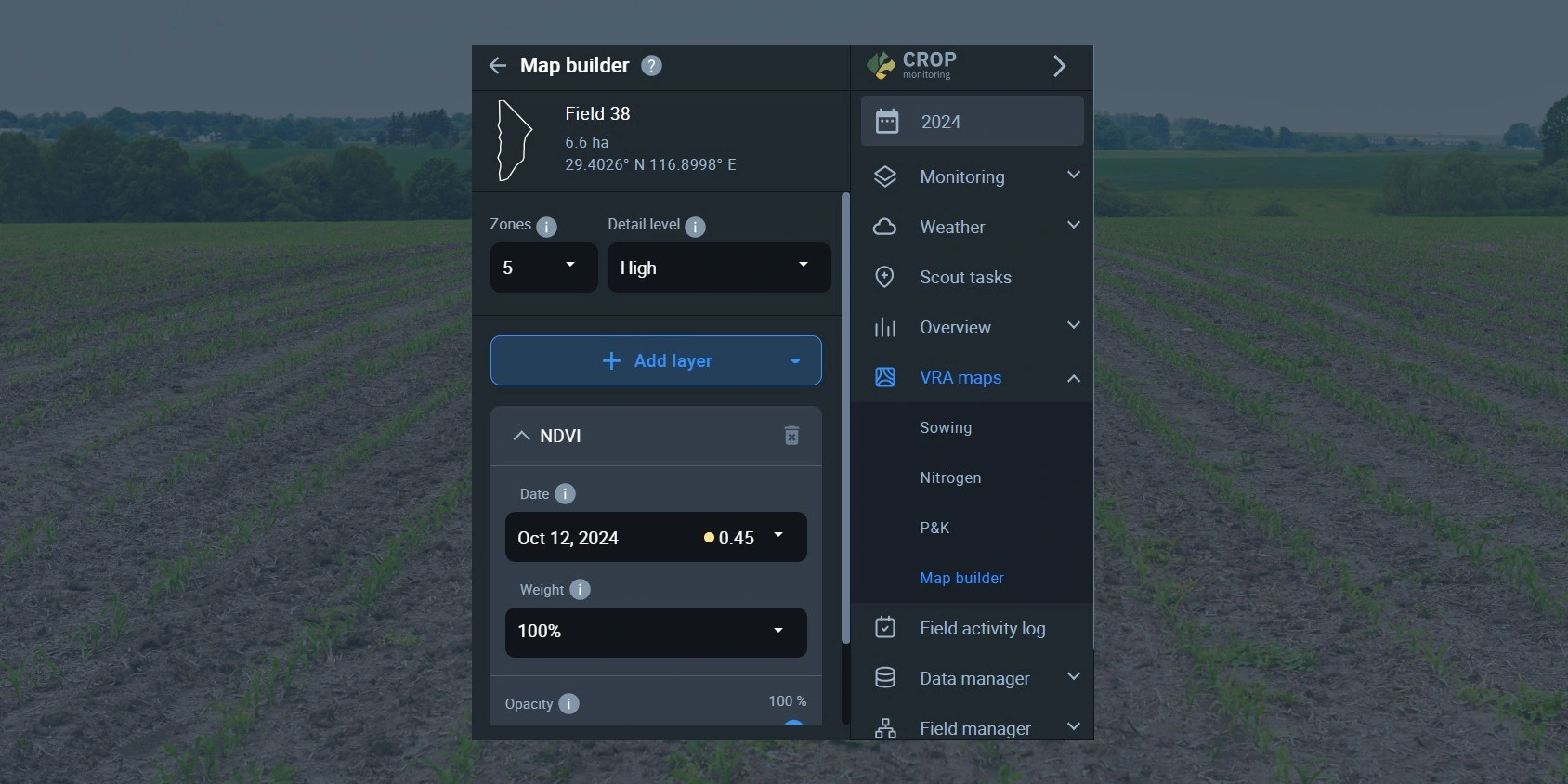
After the algorithm processes the field data, you’ll receive a VRA map based on the chosen parameters. You can then add water requirements for each management zone, export the variable rate irrigation prescription, and upload it into your equipment to guide watering.
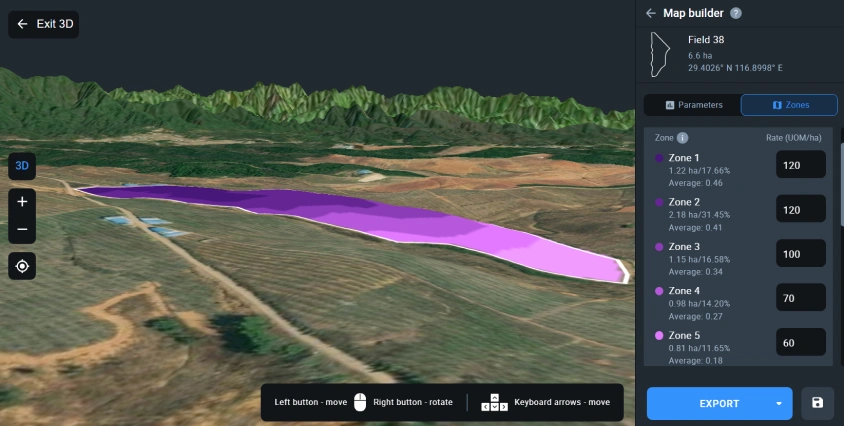
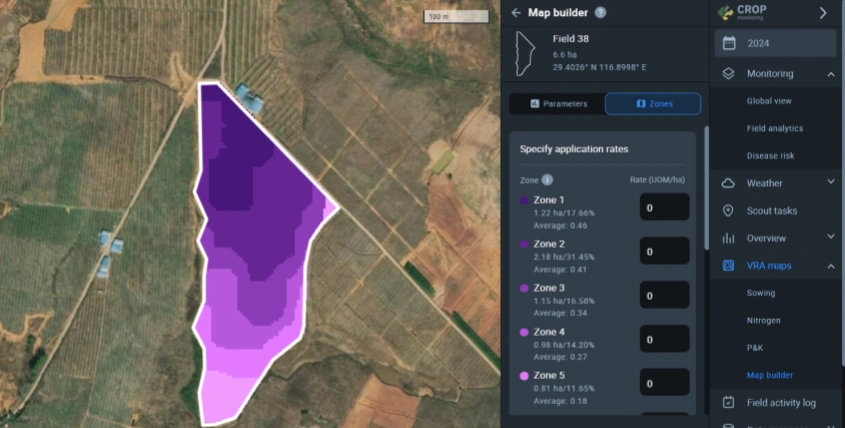
Calculate Savings From Variable Rate Irrigation
Wondering if variable rate irrigation is right for your particular field? EOSDA offers tools to calculate potential savings. Compare your current flat-rate irrigation costs against VRI estimates — fields with 5% or more cost reduction are typically good candidates for switching to variable rate watering.
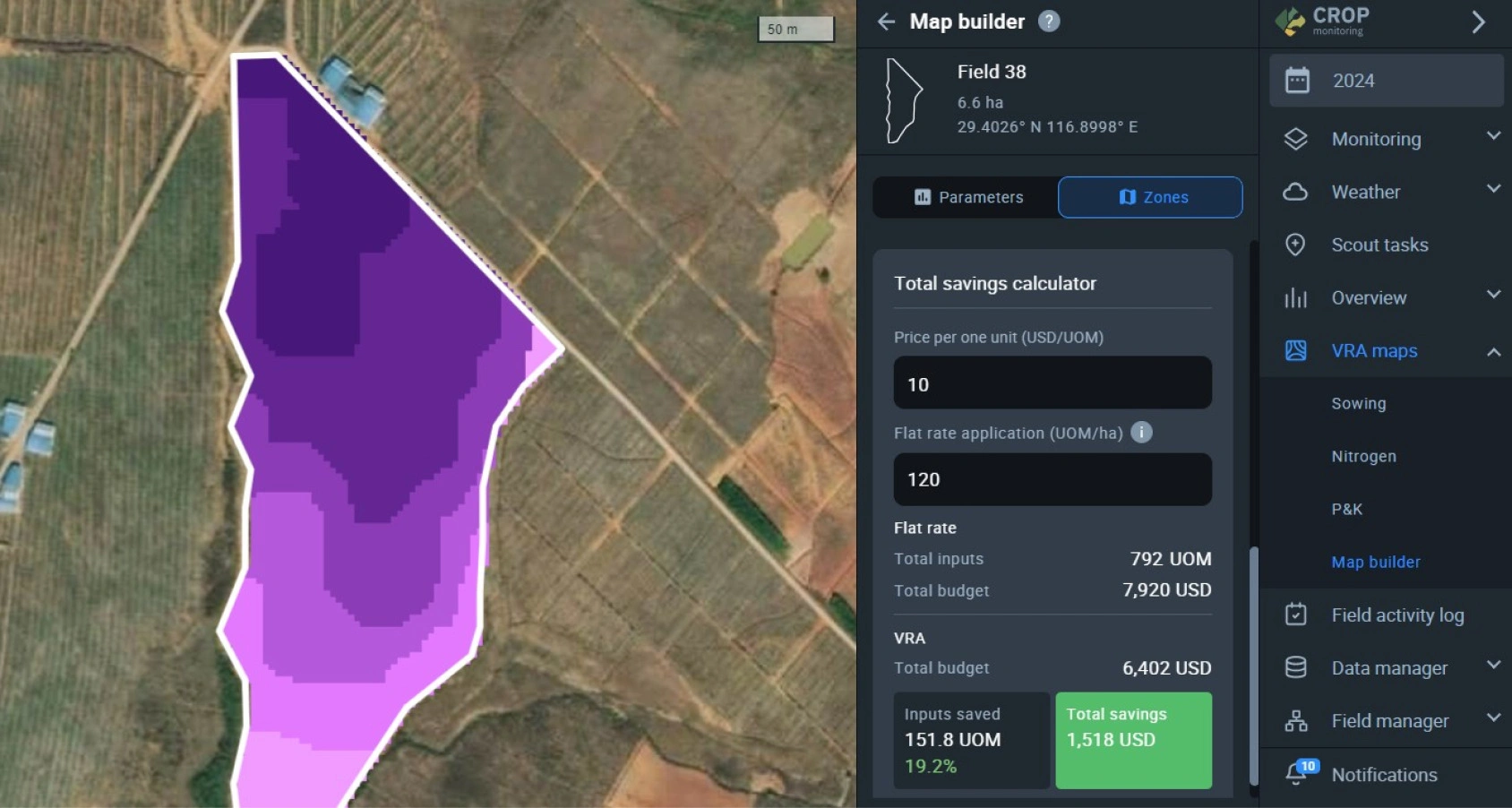
To ensure the field is suitable for variable rate application, you can conduct more detailed research on the topography and vegetation variability using our satellite-based analytical tools. Before proceeding with VRI, check the precise up-to-14-day forecast from dependable global weather providers in EOSDA Crop Monitoring. By combining field-specific insights with accurate weather data, you will know when to irrigate the fields and when just to rely on the rain.
Get in touch with our expert team at sales@eosda.com for agronomic advice on using variable rate irrigation and our complementary solutions to elevate your crop production.
About the author:
Kateryna Sergieieva has a Ph.D. in information technologies and 15 years of experience in remote sensing. She is a Senior Scientist at EOSDA responsible for developing technologies for satellite monitoring and surface feature change detection. Kateryna is an author of over 60 scientific publications.
Recent articles

Analyze 2025 & Plan Your Best Year Yet: LandViewer Christmas Offer
It’s the most wonderful time of the year! The Christmas holidays are here, and so is your chance to analyze 2025 and plan a prosperous 2026 with more affordable Pro plans in LandViewer.

EOSDA Models Climate Change Impact On Sugarcane Yields
EOSDA modeled future temperature, rainfall, and other climate impacts on Veracruz sugarcane. The results help growers plan long-term adaptation strategies, including timing, varieties, and irrigation.

EOSDA LandViewer Black Friday Sale: Exclusive Offers & Giveaway
This Black Friday, LandViewer offers new users the chance to save on monthly plans, get extra months with yearly subscriptions, and participate in a free annual plan giveaway.